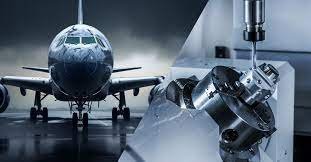Aerospace CNC Machinist

In the world of aerospace engineering, where every component must meet exacting standards of precision and reliability, the role of the CNC machinist is paramount. These skilled professionals operate computer numerical control (CNC) machines to manufacture intricate parts and components essential for aircraft, spacecraft, and other aerospace applications. As the aerospace industry continues to push the boundaries of technology and innovation, the demand for highly skilled CNC machinists remains ever-present, ensuring that every part meets the stringent requirements for safety, performance, and durability.
Precision in Motion: The CNC Machinist’s Craft
At the heart of aerospace manufacturing lies the CNC machine, a sophisticated tool that translates digital designs into physical components with unparalleled accuracy. The CNC machinist serves as the conductor of this symphony of precision, meticulously programming, setting up, and operating these machines to produce parts that adhere to the tight tolerances and specifications mandated by aerospace engineering standards.
The journey of a CNC machinist begins with a comprehensive understanding of machining principles, materials science, and computer-aided design (CAD) software. Armed with this knowledge, they embark on a path of continuous learning and refinement, honing their skills through hands-on experience and specialized training programs tailored to the aerospace industry.
Navigating Complexity: Challenges and Opportunities
Aerospace CNC machinists are no strangers to complexity. From intricate engine components to structural elements subjected to extreme forces, every part they manufacture must withstand the rigors of flight while maintaining optimal performance. This demands not only technical expertise but also a keen eye for detail and problem-solving skills to overcome the myriad challenges that arise during the manufacturing process.
One of the primary challenges faced by aerospace CNC machinists is the need to work with a diverse range of materials, including aluminum, titanium, stainless steel, and advanced composites. Each material presents its own set of machining considerations, from tool selection and cutting parameters to thermal management and surface finish requirements. Mastery of these nuances is essential to ensure the quality and integrity of the final product.
Moreover, as aerospace technology continues to evolve, CNC machinists must stay abreast of the latest advancements in machining techniques, equipment, and materials. This requires a proactive approach to professional development, including participation in industry conferences, workshops, and certification programs aimed at enhancing their skills and knowledge base.
The Intersection of Art and Science: Crafting Excellence
While CNC machining is often associated with precision and automation, there remains an element of artistry in the craft. Beyond merely following instructions, aerospace CNC machinists must possess a deep appreciation for the intricacies of their work, understanding how subtle adjustments in tooling, programming, and machining strategies can influence the outcome.
Indeed, the true mark of a skilled CNC machinist lies not only in their ability to produce parts to specification but also in their capacity to innovate and optimize the manufacturing process. Whether it’s devising more efficient tool paths, implementing novel machining techniques, or troubleshooting unforeseen issues on the shop floor, aerospace CNC machinists continually push the boundaries of what’s possible, driving progress and excellence in aerospace manufacturing.
Safety First: Upholding Quality and Compliance
In the aerospace industry, where the stakes are high and the margin for error is slim, quality and compliance are non-negotiable. Aerospace CNC machinists play a critical role in upholding these standards, adhering to strict protocols and procedures to ensure the integrity and safety of every part they produce.
From initial material inspection to final quality assurance checks, aerospace CNC machinists are vigilant guardians of quality throughout the manufacturing process. They meticulously monitor machining parameters, conduct thorough inspections, and document all relevant data to verify conformance with regulatory requirements and customer specifications.
Moreover, aerospace CNC machinists are acutely aware of the importance of traceability and documentation in the aerospace supply chain. Every step of the manufacturing process is meticulously documented, from raw material procurement and machining operations to final inspection and shipment. This ensures full transparency and accountability, facilitating compliance with industry standards and regulatory mandates.

Beyond the Horizon: Shaping the Future of Aerospace Manufacturing
As the aerospace industry continues to evolve, driven by advancements in technology, sustainability, and exploration, the role of the CNC machinist will only grow in significance. From next-generation aircraft designs to ambitious space exploration missions, aerospace CNC machinists will be at the forefront of innovation, pushing the boundaries of what’s possible in aerospace manufacturing.
However, this journey into the future will not be without its challenges. Aerospace CNC machinists will need to adapt to new technologies, such as additive manufacturing and digital twins, which promise to revolutionize the way parts are designed, produced, and maintained. Moreover, as the industry strives for greater sustainability and efficiency, aerospace CNC machinists will be called upon to embrace greener manufacturing practices and materials, minimizing waste and environmental impact while maximizing performance and reliability.
In conclusion, the role of the aerospace CNC machinist is a vital one, shaping the course of aerospace engineering and technology through their mastery of precision, innovation, and quality. As guardians of safety and excellence in aerospace manufacturing, they stand at the intersection of art and science, crafting the components that propel humanity’s exploration of the skies and beyond. As we look to the future, it is clear that the journey of the aerospace CNC machinist is one of endless possibility, driven by a relentless pursuit of excellence and a commitment to shaping a better, brighter future for aerospace engineering and technology.
